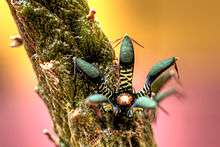Rhytidocaulon
| Rhytidocaulon | |
|---|---|
 | |
| Rhytidocaulon macrolobum | |
| Scientific classification | |
| Kingdom: | Plantae |
| (unranked): | Angiosperms |
| (unranked): | Eudicots |
| (unranked): | Asterids |
| Order: | Gentianales |
| Family: | Apocynaceae |
| Subfamily: | Asclepiadoideae |
| Genus: | Rhytidocaulon P.R.O.Bally |
Rhytidocaulon is a plant genus in the family Apocynaceae, first described in 1962.[1][2] It is native to northeastern Africa and the Arabian Peninsula
- Species[3]
- Rhytidocaulon paradoxum P.R.O.Bally - Ethiopia
- Rhytidocaulon piliferum Lavranos - Somalia
- Rhytidocaulon richardianum Lavranos - Somalia
- Rhytidocaulon subscandens P.R.O.Bally - Somalia, Ethiopia
- Rhytidocaulon tortum (N.E.Br.) M.G.Gilbert - Arabia
- species with undetermined affinities[3]
- Rhytidocaulon arachnoideum
- Rhytidocaulon baricum
- Rhytidocaulon ciliatum
- Rhytidocaulon fulleri
- Rhytidocaulon macrolobum
- Rhytidocaulon mccoyi
- Rhytidocaulon pseudosubscandens
- Rhytidocaulon sheilae
- Rhytidocaulon specksii
- Rhytidocaulon splendidum
- Taxonomy
Phylogenetic studies have shown the genus to be monophyletic, and most closely related to the Echidnopsis genus which inhabits the same region. Marginally more distantly related is a sister branch comprising the Pseudolithos genus and the widespread Caralluma stapeliads of North Africa.[4]
References
- ↑ Bally, Peter René Oscar. 1962. Candollea 18: 335
- ↑ Tropicos, genus Rhytidocaulon
- 1 2 The Plant List, Rhytidocaulon
- ↑ P. Bruyns, C. Klak, P. Hanacek: Evolution of the stapeliads (Apocynaceae-Asclepiadoideae) - repeated major radiation across Africa in an Old World group. Molecular Phylogenetics and Evolution. 2014. v. 77, no. 1, p. 251--263. ISSN 1055-7903.
This article is issued from Wikipedia - version of the 7/19/2016. The text is available under the Creative Commons Attribution/Share Alike but additional terms may apply for the media files.